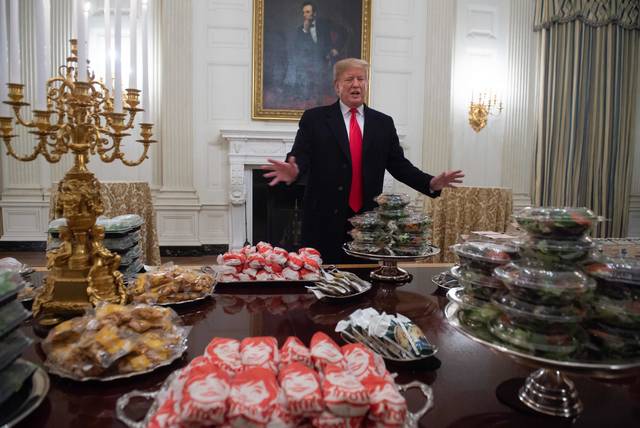https://naviga.triblive.com/opinion/jessica-myrick-trumps-love-of-fast-food-may-be-bad-for-public-health/
Jessica Myrick: Trump’s love of fast food may be bad for public health

“You are what you eat,” the old adage goes. But are you also what you watch? In a media-saturated world, it is worth considering the degree to which our exposure to media about food choices can — either directly or in more subtle ways — shape our own food beliefs and choices.
You might have seen Donald J. Trump eating McDonald’s or Kentucky Fried Chicken while traveling across the country during campaign events. You might also have seen the president serving large spreads of fast food to athletes visiting the White House to celebrate their national championships. This trend started when Trump hosted the 2018 BCS Champion Clemson Tigers. This year’s champions, the LSU Tigers, visited the White House last month.
My research has found that the ubiquity of fast food in our “media diets” can shape social acceptance and public consumption of the “all-American meal.”
Trump is not the first U.S. president to receive media attention for his fast-food consumption. Bill Clinton’s penchant for fast food was well known and frequently the focus of news coverage in the 1990s. Clinton’s love of fast food crossed over from news into popular culture when it became the basis of actor Phil Hartman’s parody of Clinton on “Saturday Night Live,” with Hartman-as-Clinton stopping in the middle of a workout to eat at a McDonald’s. Eventually, though, Clinton had quadruple bypass surgery and adopted a vegan diet in hopes of avoiding a heart attack.
Media coverage of events related to presidential food choices, like Trump serving fast food to football champions, may shape our own food choices. In particular, if Trump can eat fast food and still receive glowing results on his annual physical exam, then Americans may likewise assume they can eat fast food without fear of negative health consequences.
My research set out to assess the role of media coverage and mediated perceptions of Trump in shaping public perceptions of fast food and intentions to eat it. I conducted a national representative survey of more than 1,000 Americans and asked them about their demographic backgrounds, attention to media about Trump, and their beliefs, attitudes and intentions regarding fast food.
The results of this survey, published in the peer-reviewed journal Appetite, show that people who pay more attention to media coverage of Trump’s diet are more likely to view fast food as a socially acceptable meal option and are more likely to intend to eat fast food in the near future.
In fact, attention to media about Trump’s diet was a stronger predictor of intentions to eat fast food than any demographic factor, such as education level, race, age, gender or income.
People who felt like they knew Trump — thought of him as an acquaintance, what media scholars call having a “parasocial relationship” — were also more likely to report perceiving fast food as a socially acceptable meal. This and other parts of the study’s findings suggest that the more media about a president we consume, the more likely we are to adopt some of his dietary beliefs, too.
However, not everyone will respond the same way to news coverage of Trump’s preference for fast food. Republicans who paid attention to media coverage of Trump’s diet were the more likely than Democrats or individuals unaffiliated with either major party to view fast food as an acceptable meal option.
The survey results revealed that even Democrats who viewed enough media about the president that they developed a parasocial relationship with him were likely to view fast food as an acceptable meal option. However, for Republicans, this relationship was nearly twice as strong, meaning that as attention to media coverage of Trump’s diet increases, Republicans are quicker to report positive attitudes toward fast food than are Democrats.
Even if the effects of media coverage of Trump’s love of fast food are small at the individual level, when you aggregate those effects across the entire U.S. population, these data indicate the president’s diet could have ripple effects that cause harm to public health.
Food beliefs and choices are of keen interest to researchers and public health officials. Nearly 40% of adults in the U.S. are obese, with about 20% of children in the U.S. also qualifying as obese. One type of food, in particular, is strongly related to obesity rates in the U.S.: fast food.
Food choices can be political, but at the presidential level, the politics of fast food have ramifications for all of us. Given the huge toll of obesity on individual health and the health care system, it is worth considering the effects of not only the political but also dietary leadership at the top of our executive branch.
Jessica Myrick, Ph.D., is an associate professor of communications at Penn State.
Copyright ©2025— Trib Total Media, LLC (TribLIVE.com)
